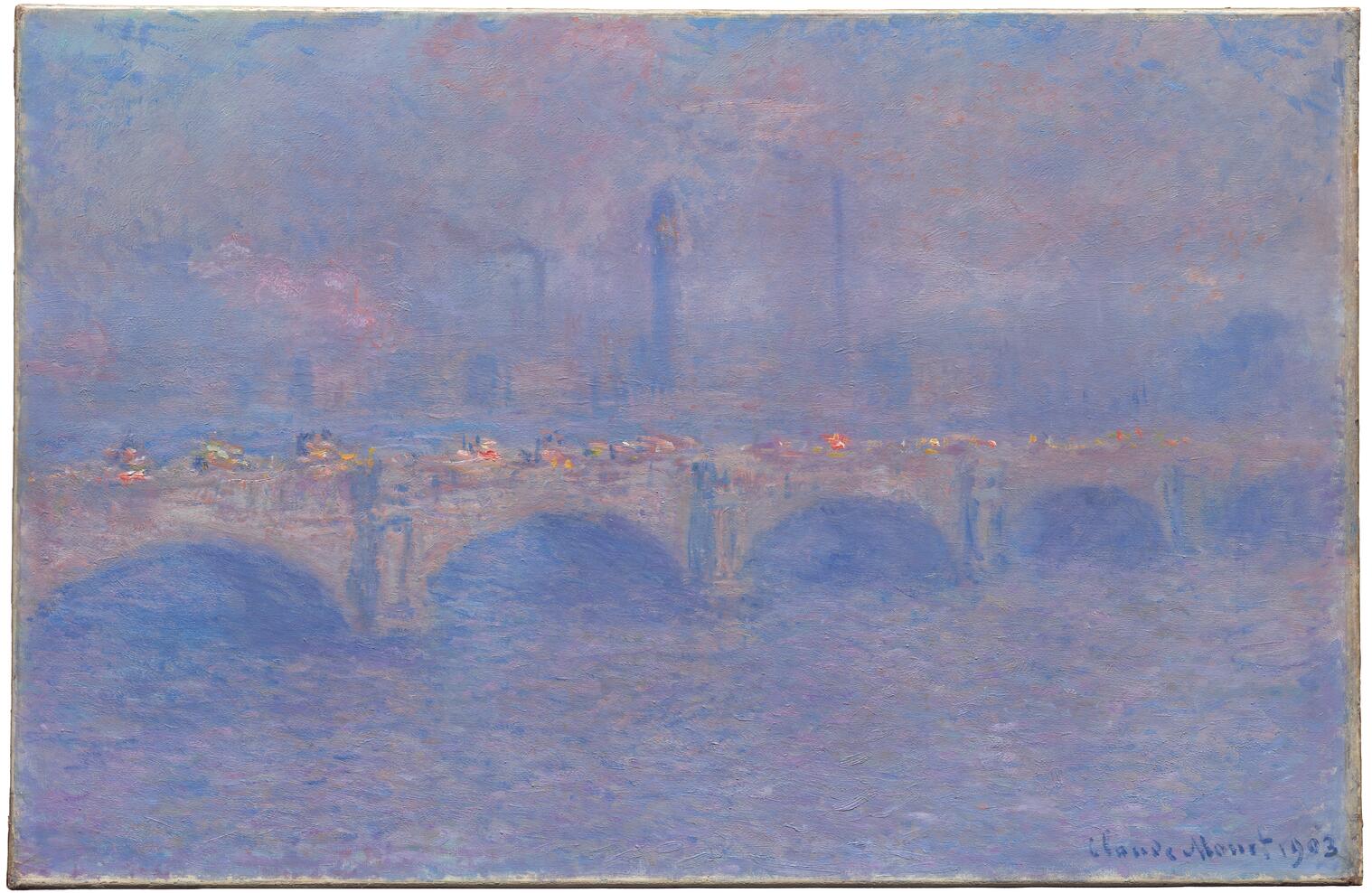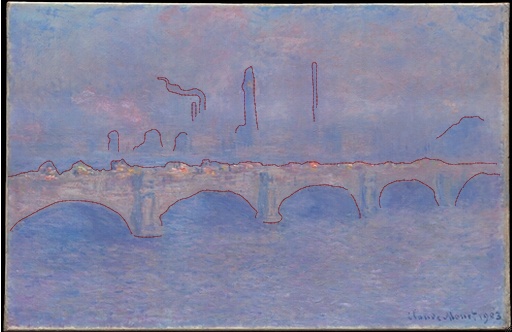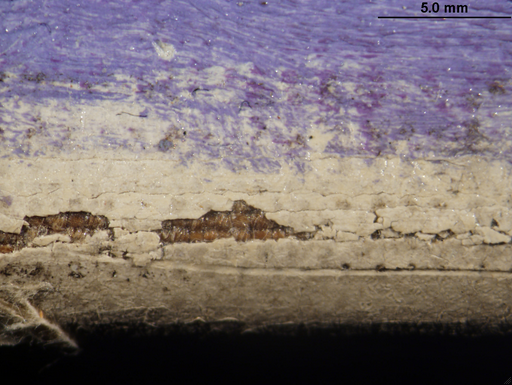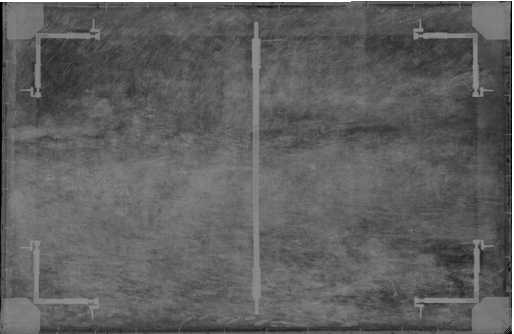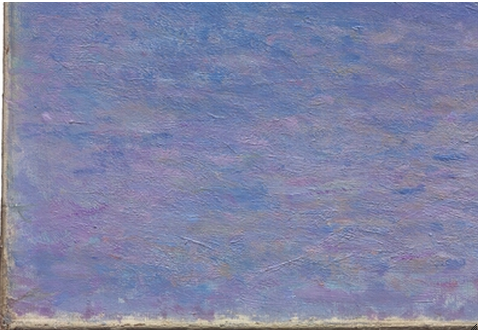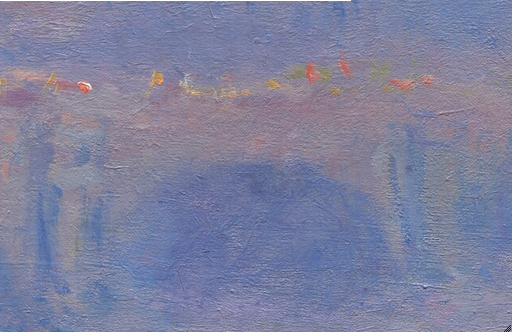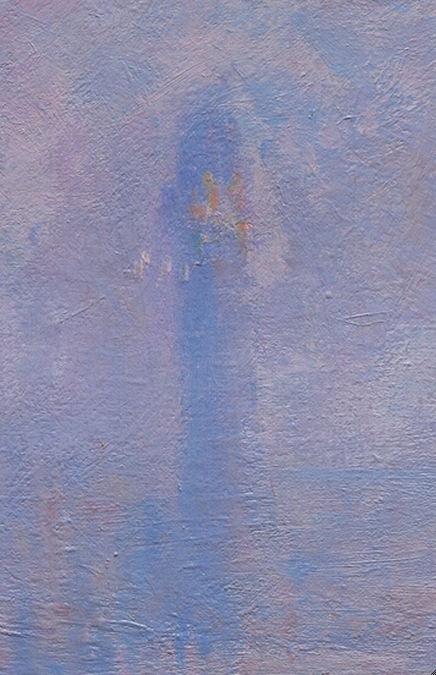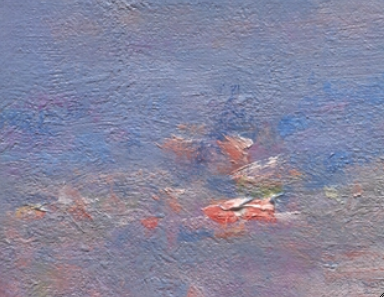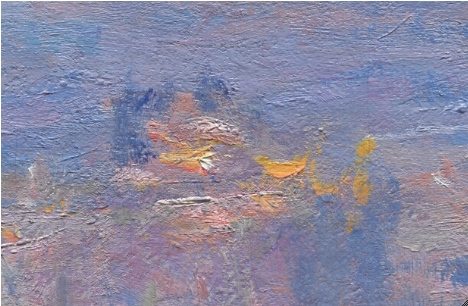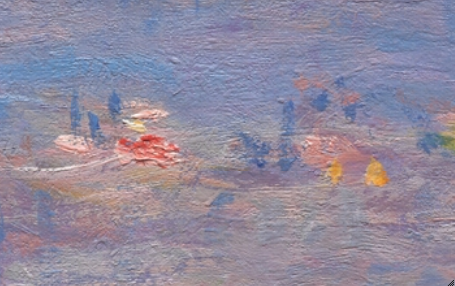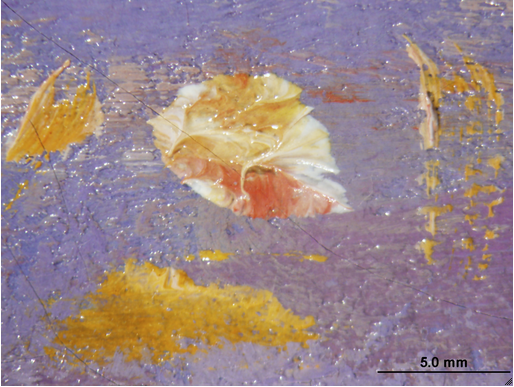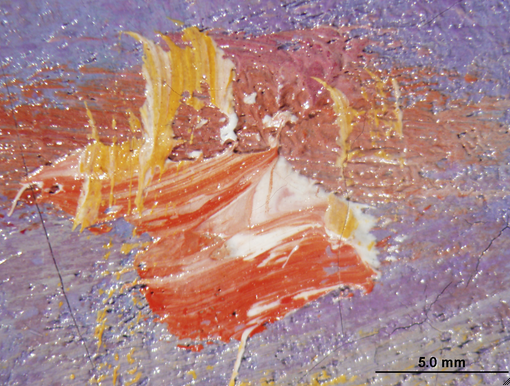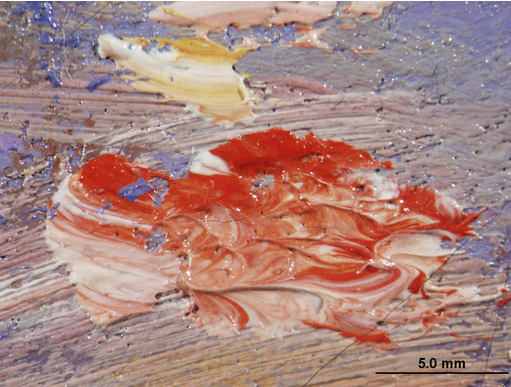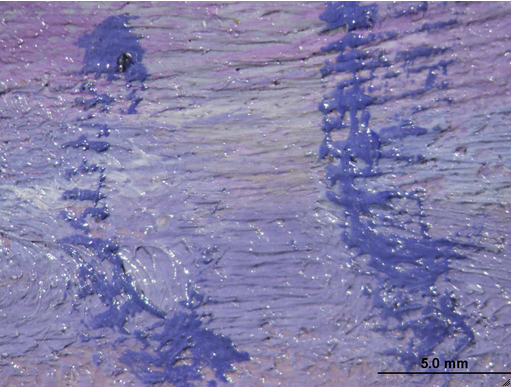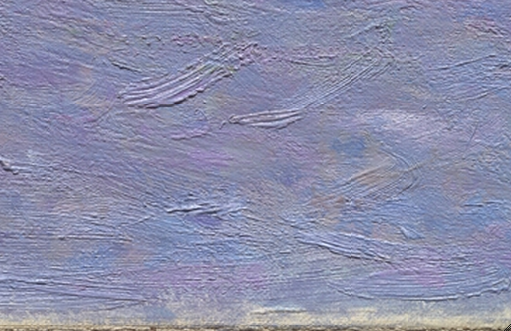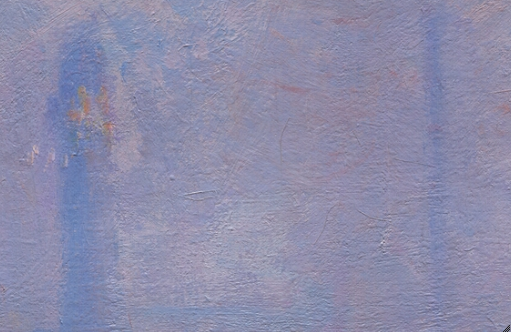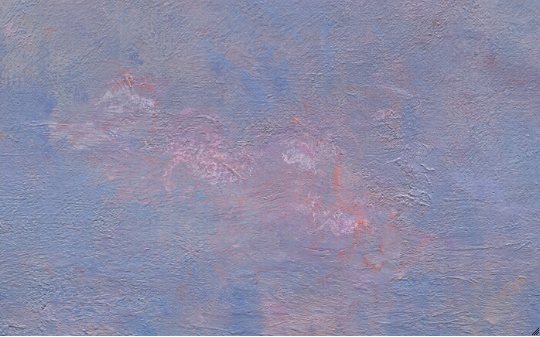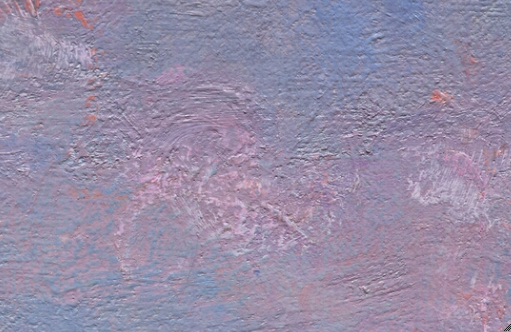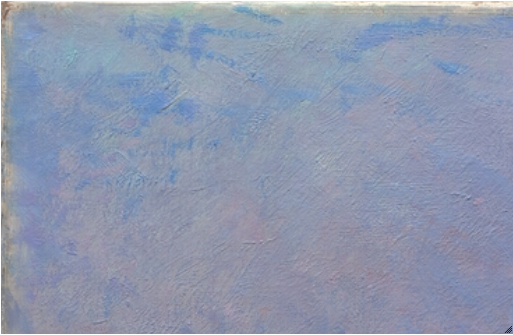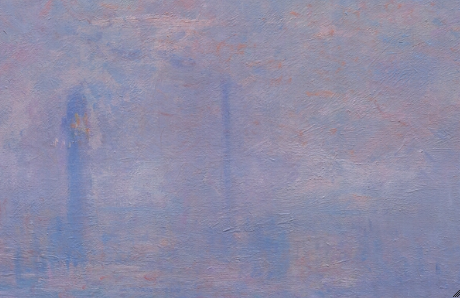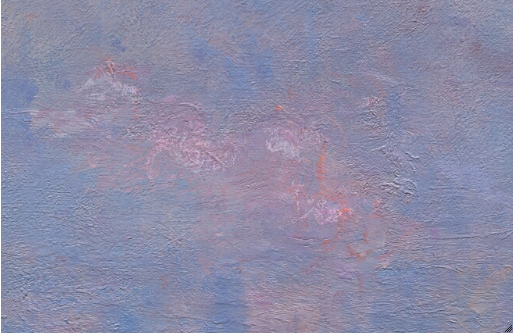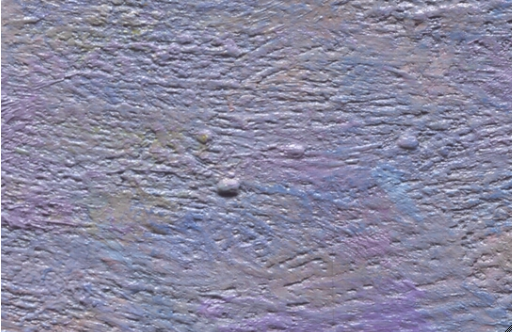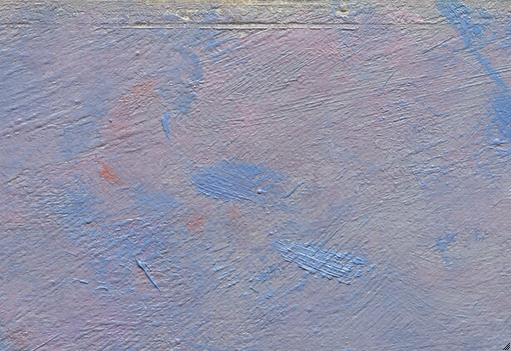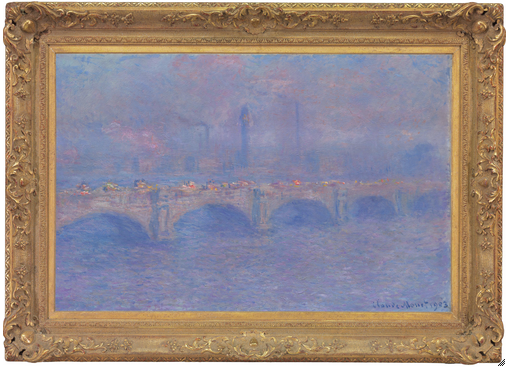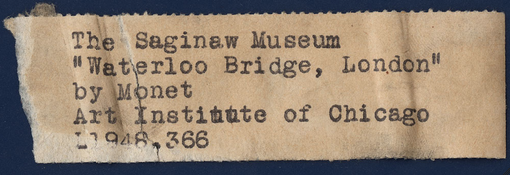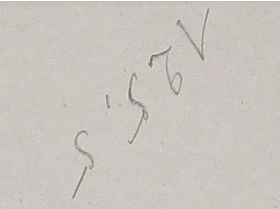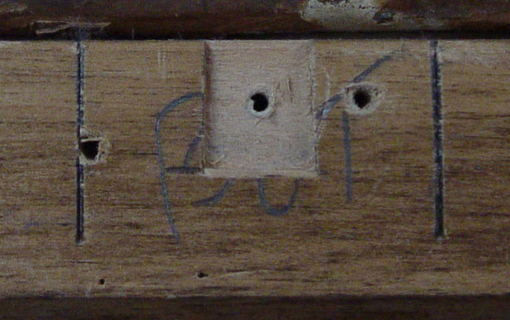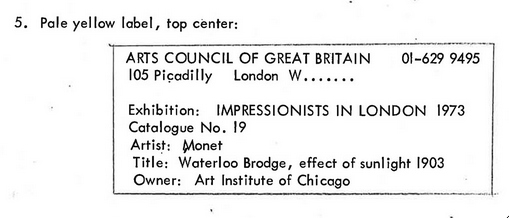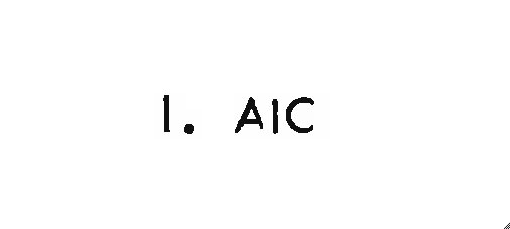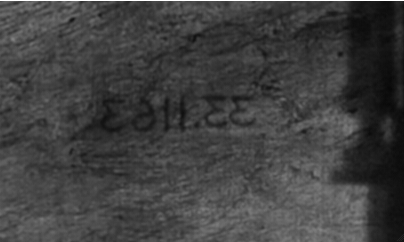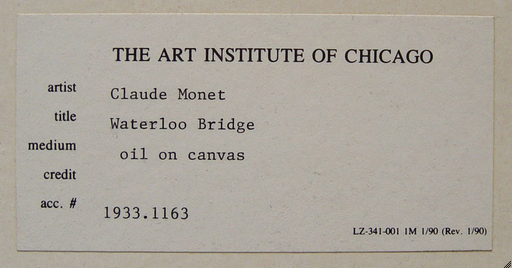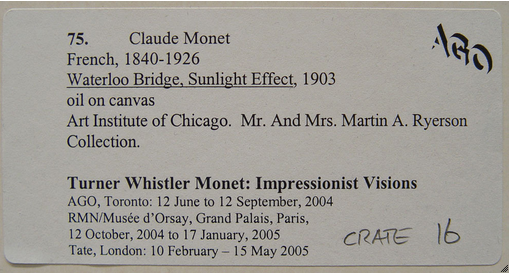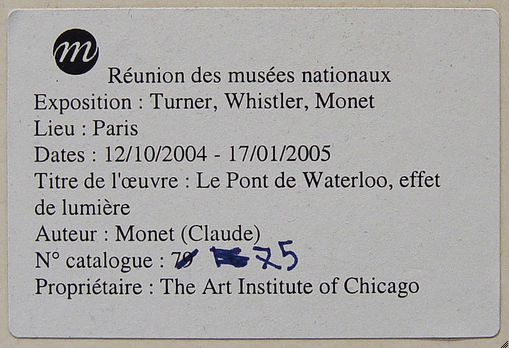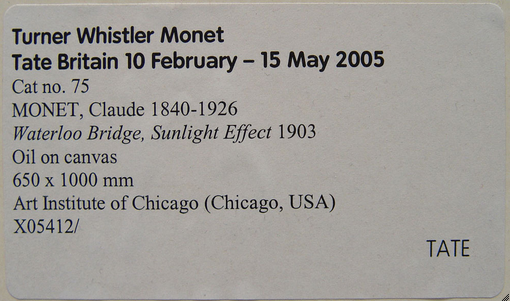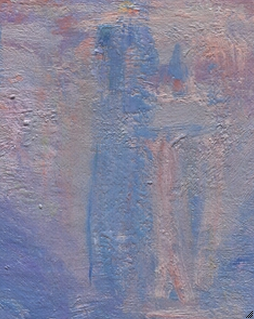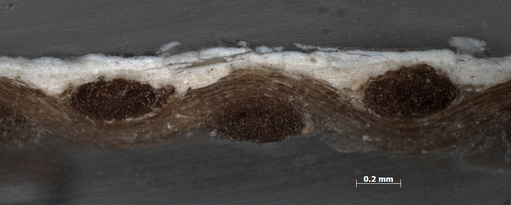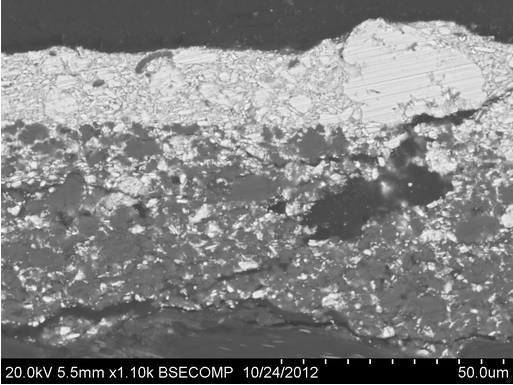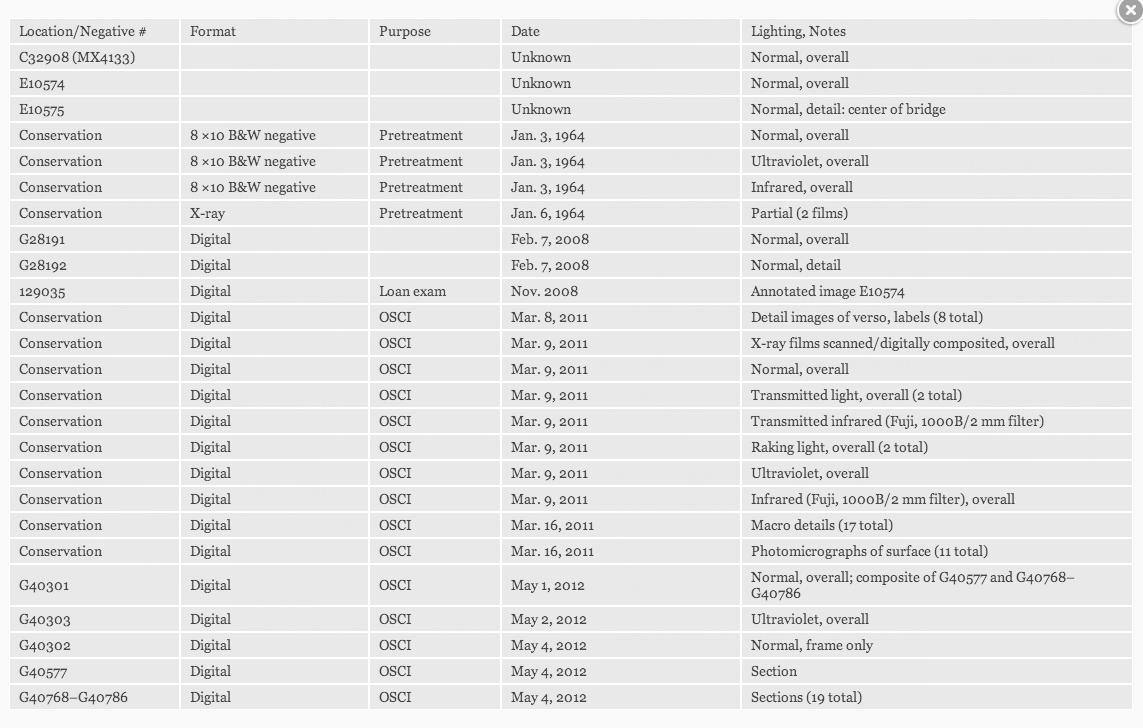Cat. 39
Waterloo Bridge, Sunlight Effect
1903
Oil on canvas; 65.7 × 101 cm (25 7/8 × 39 3/4 in.)
Signed and dated: Claude Monet 1903 (lower right, in blue paint)
The Art Institute of Chicago, Mr. and Mrs. Martin A. Ryerson Collection, 1933.1163
Technical Report
Technical Summary
Claude Monet’s Waterloo Bridge, Sunlight Effect was executed on a [glossary:pre-primed], no. 40 seascape ([glossary:marine]) standard-size linen [glossary:canvas]. A stamp, transcribed from the back of the original canvas, indicates that the canvas was purchased in London from the French supplier Lechertier Barbe Ltd. The off-white [glossary:ground] consists of two layers. The work appears to have been carried out in several sessions. There are no apparent alterations to the composition; because the painting was rather thickly built up in large areas, however, it is difficult to interpret the underlying paint layers. The paint surface consists of low-relief texture, often coming from earlier brushstrokes beneath the surface. The handling of the brushwork creates a somewhat uniform surface across much of the sky and the water. The bridge and the skyline were reduced to their basic forms; the only details depicted were the columns of the bridge and the crossing traffic. These elements were sketchily rendered with a few quick strokes, but they were painted with more intense colors—including bright yellow and orange—than in the rest of the painting.
Multilayer Interactive Image Viewer
The multilayer interactive image viewer is designed to facilitate the viewer’s exploration and comparison of the technical images (fig. 1).
Signature
Signed and dated: Claude Monet 1903 (lower right corner, in blue paint) (fig. 2). The underlying paint layers were dry when the painting was signed.
Structure and Technique
Support
Canvas
Flax (commonly known as linen).
Standard format
The original dimensions were approximately 65 × 100 cm. This corresponds to a no. 40 seascape (marine) standard-size canvas.
Weave
[glossary:Plain weave]. Average [glossary:thread count] (standard deviation): 14.8V (0.3) × 14.8H (0.4) threads/cm; the vertical threads were determined to correspond to the [glossary:warp] and the horizontal threads to the [glossary:weft]. No weave matches were found with other Monet paintings analyzed for this project.
Canvas characteristics
There is moderate [glossary:cusping] on the left and right edges of the canvas, and slight cusping along the top and bottom edges.
Stretching
Current stretching: Dates to 1991 conservation treatment (see Conservation History); copper tacks spaced 5–9 cm apart.
Original stretching: Most tack holes spaced approximately 10–11 cm apart. The cusping appears to correspond to the placement of the original tack holes on all sides. There are a few additional holes on the top and bottom edges. These probably relate to tacks added later to reinforce the edges.
Stretcher/strainer
Current stretcher: [glossary:ICA spring stretcher]; dates to 1964 conservation treatment (see Conservation History). Depth: 2.5 cm.
Original stretcher: Discarded. The pre-1964-treatment [glossary:stretcher] was probably the original stretcher. A 1959 examination report describes it as a five-membered, keyable stretcher with a vertical [glossary:crossbar]. Depth: Not documented. Based on a second crease in the [glossary:tacking margins], presumably where excess canvas was folded over the back edge of the stretcher, the original stretcher depth was approximately 2 cm.
Manufacturer’s/supplier’s marks
Although a stamp on the back of the original canvas (now obscured by the [glossary:lining] canvas was transcribed as “Barber London, S.W.” (fig. 3), the canvas was probably purchased from Lechertier Barbe Ltd. in London.
Preparatory Layers
Sizing
Not determined (probably glue).
Ground application/texture
The ground layer extends to the edges of the top, bottom, and right tacking margins, indicating that the canvas was cut from a larger piece of primed fabric on those edges. Unprimed canvas is visible along the left tacking edge; because of the presence of paper strips adhered to the edges, however, it is difficult to determine whether the ground originally stopped short of this edge or whether the ground has come away with the paper in the areas where the canvas is exposed (fig. 4). The canvas was probably commercially prepared. Analysis indicates that the ground consists of two layers. The lower layer ranges from approximately 20 to 90 µm in thickness. The upper layer ranges from approximately 15 to 65 µm in thickness (fig. 15.64).
Color
When the painting is observed under a microscope, it can be seen that the ground has an off-white tone (fig. 5). [glossary:Cross-sectional analysis] indicates that the lower layer is more toned, containing black, red, and brown pigment particles (fig. 15.64).
Materials/composition
Analysis indicates that the lower layer contains lead white and calcium carbonate (chalk) with traces of barium sulfate, silica, silicates, bone black, iron oxide brown, and a zinc compound. The upper layer contains lead white with minor amounts of calcium carbonate (chalk) and traces of barium sulfate, silica, silicates, and a zinc compound. Binder: [glossary:Oil] (estimated).
Compositional Planning/Underdrawing/Painted Sketch
Extent/character
No [glossary:underdrawing] was observed with [glossary:infrared reflectography] (IRR) or microscopic examination.
Paint Layer
Application/technique and artist’s revisions
The work was built up directly from the initial [glossary:lay-in] with no apparent alterations to the composition as the painting progressed. The paint layers, however, are quite thickly built up—the [glossary:X-ray] shows dense paint application over much of the surface, especially in the area of the bridge and the water (fig. 6)—making it difficult to discern even the final compositional forms in the X-ray, far less any changes that may have occurred in earlier paint layers. The ground layer is completely covered by the buildup of paint, remaining visible only near the edges of the canvas (fig. 8).
The composition is dominated by pale-blue and pale-violet tones. The paint application consists largely of touches of discrete color, often built up over more broadly applied underlayers of pale bluish-gray in a somewhat sketchy manner with very little articulation of detail, creating a uniformity over the surface of the water and the sky. Architectural forms, such as the distant smokestacks and the columns and arches of the bridge, are cursorily indicated using slightly more-intense blue paint (fig. 9, fig. 10). In general, there are no distinct edges to these elements, causing them to visually dissolve into adjacent areas of the painting. The sunlight, coming from beyond the right edge of the painting, illuminates the side of the bridge, highlighting it and the traffic that travels along the top. The vehicles are executed using a few quick brushstrokes (fig. 7, fig. 12.12, fig. 12.13), with low [glossary:impasto] daubs of bright orange, red, and white—among the most brilliant color used in the painting—added as final touches (fig. 17.71, fig. 15.32).
In general, the paint seems to have had a rather viscous consistency, especially earlier layers that retain the crisp marks of the brush application (fig. 17.72). In fact, much of the low-relief surface texture is due to underlying brushstrokes whose texture remains evident even though the colors have been covered by subsequent brushwork (fig. 15.34). There is some [glossary:wet-on-wet] paint application but virtually no working or blending together of brushstrokes on the canvas. For the most part, the upper paint layers were built up in a network of individual strokes, carried out in several sessions, which allowed earlier layers to become surface dry before additional layers were applied on top. In a few places, broader, more-fluid paint applications were used; these sometimes allow the texture from beneath to show through and other times impart a relatively smooth, flat surface (fig. 15.58). In some areas of the painting, the artist likely worked back into the still-soft paint, either lightly scraping or wiping the surface to expose underlying layers in discrete areas. This is particularly evident in the cloud of pale-pink smoke in the left background of the composition (fig. 15.36). Here, some of the thinly applied pinkish paint has been lightly removed from the high points of the surface, revealing pale-greenish-gray layers from underneath (fig. 15.33). A few final touches, such as the bright-blue and pale-orange-red strokes in the sky, were lightly dragged across the surface (fig. 15.37, fig. 15.38).
Small inclusions underneath the paint surface, seen occasionally throughout the water and in the sky, have the appearance of dried paint, possibly picked up on the brush from the artists’ palette (fig. 15.39). Ridges in the paint, seen in places on all four sides, were probably caused by framing of the work before the paint layers were dry (e.g. fig. 15.40).
Painting tools
Brushes, including 0.5, 0.7, 1.0 and 1.5 cm width (based on width and shape of brushstrokes). Several brush hairs are embedded in the paint layers.
Palette
Analysis indicates the presence of the following [glossary:pigments]: lead white, cadmium yellow, vermilion, red lake, viridian, cobalt blue, ultramarine blue, and cobalt violet.
Binding Media
Oil (estimated).
Surface Finish
Varnish layer/media
The painting has an even, slightly glossy, [glossary:synthetic varnish] layer. The 1959 examination report indicates that the painting was unvarnished at that time; this may have been the original surface.
Conservation History
In 1959, the back of the canvas was vacuumed, three missing [glossary:keys] were replaced, the corners of the canvas were restretched, the stretcher was keyed out slightly, and losses at the lower left and lower right corners were consolidated with wax-resin adhesive. Surface grime was removed, and a spray coat of L44/46 (Lucite: butyl methacrylate) was applied.
In 1964, the [glossary:varnish] and [glossary:retouching] applied in 1959 were removed. The canvas was wax-resin lined and restretched onto a new ICA spring stretcher. A spray coat of polyvinyl acetate (PVA) AYAA was applied. Losses were inpainted. A final spray coat of AYAA was applied.
In 1999, an area on the back of the stretcher, where the original canvas had delaminated from the lining canvas, was readhered using a tacking iron. The lining canvas was then readhered to the stretcher back.
Condition Summary
The painting is in good condition. The canvas is wax-resin lined and stretched taut and in plane on an ICA spring stretcher. There is some deterioration of the canvas, and abrasion and loss of the ground layer, on the [glossary:tacking edges]. There are old paper and adhesive residues on the tacking edges. Ridges in the paint layers seen along all four edges are probably related to framing when the paint was still soft. There are localized damages in the paint layer around the lower left and lower right corners, and small losses along some of the original foldovers. Associated retouching in these areas is slightly mismatched but unobtrusive. Thin layers of retouching are especially noticeable along the right edge, where more of the ground layer from the original tacking edge was incorporated into the picture plane when the painting was restretched after lining; this is mostly concealed by the frame. Microscopic examination revealed some traces of old retouching in the pale-pink smoke cloud on the left side of the sky. Cracking is minimal and where present is very fine; where it is visible to the naked eye, cracking is concentrated in areas where the paint is thickly layered, for example, on the left side of the bridge and left of the central tower. The painting has an even, semiglossy, synthetic varnish layer.
Kimberley Muir
Frame
The current frame appears to be original to the painting. It is a French (Parisian), early-twentieth-century, Durand-Ruel, Régence Revival, ogee frame with cast foliate and center cartouches with cabochon centers on a quadrillage bed, leaf-tip-and-shell sight molding, and an independent fillet liner. The frame has both water and oil gilding. Ornament on the ogee face and sight molding have been selectively burnished; the liner has been left matte. Red bole was used on the perimeter molding, the ogee face and ornament, the sight molding, and the scotia sides. Red-orange bole was used on the sanded frieze and bordering fillets. The frame has an overall raw umber tone, on top of which casein or gouache gray washes and dark flecking were applied. The glued poplar substrate is mitered and nailed. Half-lap corner and center braces were glued and nailed between the perimeter and interior back edge boards. This frame illustrates the original Durand-Ruel construction. Over this wood molding a cast plaster face was applied. At a later date a partial back frame was attached with screws. The molding, from perimeter to interior, is fillet with stylized, running undulating bands with rhomboid center punches; scotia side; ogee face with a cast quadrillage bed and center and corner foliate and floral cartouches with cabochon centers on a double-lined diamond bed with punched centers; fillet; sanded front frieze; fillet; ogee with stylized leaf-tip-and-shell sight molding; and an independent fillet liner with cove sight (fig. 15.41).
Kirk Vuillemot
Provenance
Sold by the artist to Durand-Ruel, Paris, May 11, 1904, for 9,000 francs.
Sold by Durand-Ruel, Paris, to Durand-Ruel, New York, Dec. 14, 1904 or Jan. 6, 1905.
Sold by Durand-Ruel, New York, to W. A. Putnam, Jan. 10, 1905, for $4,000.
Sold by W. A. Putnamto Durand-Ruel, New York, May 22, 1913, for 25,000 francs.
Sold by Durand-Ruel, New York, to Martin A. Ryerson, Chicago, Feb. 10, 1914, for $7,500.
Bequeathed by Martin A. Ryerson (died 1932), Chicago, to the Art Institute of Chicago, 1933.
Exhibition History
Paris, Galeries Durand-Ruel, Claude Monet: Vues de la Tamise à Londres, May 9–June 4, 1904, cat. 18, as Effet de Soleil. 1903, under the heading Waterloo Bridge.
Boston, Copley Society, Loan Collection of Paintings by Claude Monet and Eleven Sculptures by Auguste Rodin, Mar. 1905, cat. 49, as La Tamise à Londres. Effet de Soleil. (Waterloo Bridge.) 1903. Lent by W. A. Putnam, Esq.
Chicago, Stratford Hotel, Tableaux Durand-Ruel, late Jan.–early Feb. 1914, no cat. no.
Bloomington, Indiana, Indiana University, Fine Arts Department, French Painting of the 19th-Century, Nov. 15–Dec. 5, 1942, no cat.
Dayton, Ohio, Dayton Art Museum, 19th Century French Paintings from the Collection of the Art Institute of Chicago (circuit exhibition organized by the American Federation of Arts), June 1–June 22, 1948, no cat.; Springfield (Mo.) Art Museum, Sept. 9–30, 1948, no cat.; Probably Poughkeepsie, N.Y., Vassar College Art Gallery, Oct. 15–Nov. 5, 1948; Probably Manchester, N.H., Currier Gallery of Art, Nov. 16–Dec. 7, 1948; Saginaw (Mich.) Museum, [as Exhibition of Nineteenth Century French Painting, Dec. 19, 1948–Jan. 9, 1949, cat. 20; Probably Omaha, Neb., Joslyn Memorial Art Museum, Jan. 23–Feb. 15, 1949; Probably Memphis, Tenn., Brooks Memorial Art Gallery, Mar. 1–22, 1949, no cat.; Utica, N.Y., Munson–Williams-Proctor Institute, Apr. 3–24, 1949, no cat.
Art Institute of Chicago, The Paintings of Claude Monet, Apr. 1–June 15, 1957, no cat. no.
San Francisco Museum of Art, Civic Center, Nov. 1959, no cat. London, Hayward Gallery, The Impressionists in London, Jan. 3–Mar. 11, 1973, cat. 19 (ill.).
New York, David T. Schiff, Feb. 3–May 30, 1975, no cat.
Shelburne (Vt.) Museum, Apr. 19–Nov. 3, 1995, no cat.
Florence, Sala Bianca di Palazzo Pitti, Claude Monet: La poesia della luce; Sette capolavori dell’Art Institute di Chicago a Palazzo Pitti, June 2–Aug. 29, 1999, no cat. no. (ill.).
Toronto, Art Gallery of Ontario, Turner; Whistler; Monet, June 12–Sept. 12, 2004, cat. 75 (ill.); Paris, Galeries Nationales, Grand Palais, Oct. 12, 2004–Jan. 17, 2005; London, Tate Britain, Feb. 10–May 15, 2005.
Fort Worth, Tex., Kimbell Art Museum, The Impressionists: Master Paintings from the Art Institute of Chicago, June 29–Nov. 2, 2008, cat. 87 (ill.).
Selected References
Galeries Durand-Ruel, Claude Monet: Vues de la Tamise à Londres, exh. cat. (Galeries Durand-Ruel, 1904), p. 10, cat. 18.
Gustave Kahn, “L’exposition Claude Monet,” Gazette des beaux-arts 32 (July 1904), p. 87, n. 3.
Copley Society, Loan Collection of Paintings by Claude Monet and Eleven Sculptures by August Rodin, exh. cat. (Copley Society, 1905), p. 20, cat. 49.
Art Institute of Chicago, A Guide to the Paintings in the Permanent Collection (Art Institute of Chicago, 1925), p. 162, cat. 2148.
M. C., “Monets in the Art Institute,” Bulletin of the Art Institute of Chicago 19, 2 (Feb. 1925), p. 21.
Daniel Catton Rich, “Französische Impressionisten im Art Institute zu Chicago,” Pantheon: (Mar. 1933), p. 77. Translated by C. C. H. Drechsel as “French Impressionists in the Art Institute of Chicago,” Pantheon/Cicerone (Mar. 1933), p. 18.
Oscar Reuterswärd, Monet: En konstnärshistorik (Bonniers, 1948), p. 287.
Saginaw Museum, Exhibition of Nineteenth Century French Painting at The Saginaw Museum, exh. cat. (Saginaw Museum, 1949), p. 9, cat. 20.
Art Institute of Chicago,“Catalogue,” Art Institute of Chicago Quarterly 51, 2 (Apr. 1, 1957), p. 34.
Art Institute of Chicago,“Chronology,” Art Institute of Chicago Quarterly 51, 2 (Apr. 1, 1957), p. 31 (ill.).
Art Institute of Chicago, Paintings in the Art Institute of Chicago: A Catalogue of the Picture Collection (Art Institute of Chicago, 1961), p. 322.
A. James Speyer, “Twentieth-Century European Paintings and Sculpture,” Apollo 84, 55 (Sept. 1966), p. 222.
Denis Rouart, “Apparences et reflets,” in Denis Rouart and Jean-Dominique Rey Monet, nymphéas, ou Les miroirs du temps, with a cat. rais. by Robert Maillard (Hazan, 1972), p. 34 (ill.).
Anthea Callen, The Impressionists in London, exh. cat. (Arts Council of Great Britain, 1973), p. 45, cat. 19 (ill.).
A. James Speyer and Courtney Graham Donnell, Twentieth-Century European Paintings (University of Chicago Press, 1980), p. 59, cat. 3B1; microfiche 3, no. 3B1 (ill.).
Grace Seiberling, Monet’s Series (Garland, 1981), p. 373, no. 28.
Daniel Wildenstein, Claude Monet: Biographie et catalogue raisonné, vol. 4, Peintures, 1899–1926 (Bibliothèque des Arts, 1985), pp. 180; 181, cat. 1586 (ill.); 365, letters 1723 and 1724; 429, pièce justificative 220.
Richard R. Brettell, Post-Impressionists (Art Institute of Chicago/Abrams, 1987), pp. 90 (detail); 91; 95 (ill.); 118.
Andrew Forge, Monet, Artists in Focus (Art Institute of Chicago, 1995), pp. 56; 57; 101, pl. 30; 109.
Daniel Wildenstein, Monet: Catalogue raisonné/Werkverzeichnis, vol. 3, Nos. 969–1595 (Taschen/Wildenstein Institute, 1996), pp. 694–95, cat. 1586 (ill.).
Simonella Condemi and Andrew Forge, Claude Monet: La poesia della luce; Sette capolavori dell’Art Institute di Chicago a Palazzo Pitti, exh. cat. (Giunti Gruppo, 1999), pp. 44–45 (ill.), 46–47 (detail).
Karin Sagner-Düchting, “Monet’s Late Work from the Vantage Point of Modernism,” in Monet and Modernism, ed. Karin Sagner-Düchting, exh. cat. (Prestel, 2001), p. 25.
Karin Sagner-Düchting, “The London Paintings,” in Monet and Modernism, ed. Karin Sagner-Düchting, exh. cat. (Prestel, 2001), pp. 58, 63 (ill.).
John House, “Tinted Steam: Turner and Impressionism,” in Turner; Whistler; Monet: Impressionist Visions, ed. Katharine Lochnan, exh. cat. (Art Gallery of Ontario/Tate Publishing, 2004), p. 47.
Sylvie Patin, “The Return of Whistler and Monet to the Thames” in Turner; Whistler; Monet: Impressionist Visions, ed. Katharine Lochnan, exh. cat. (Art Gallery of Ontario/Tate Publishing, 2004), pp. 192, no. 75; 194, no. 75 (ill.).
John E. Thornes and Gemma Metherell, “The Art and Science of London’s Atmosphere around 1900,” in London’s Environment: Prospects for a Sustainable City, ed. Julian Hunt (Imperial College Press, 2005), p. 119.
Barry Venning, “Turner, Monet e l’impressionismo,” in Turner e gli impressionisti: La grande storia del paesaggio moderno in Europa, ed. Marco Goldin, exh. cat. (Linea d’Ombra, 2006), p. 78 (ill.).
Gloria Groom and Douglas Druick, with the assistance of Dorota Chudzicka and Jill Shaw, The Impressionists: Master Paintings from the Art Institute of Chicago, exh. cat. (Art Institute of Chicago/Kimbell Art Museum, 2008), pp. 153 (detail); 168; 169, cat. 87 (ill.). Simultaneously published as Gloria Groom and Douglas Druick, with the assistance of Dorota Chudzicka and Jill Shaw, The Age of Impressionism at the Art Institute of Chicago (Art Institute of Chicago/Yale University Press, 2008), pp. 153 (detail); 168; 169, cat. 87 (ill.).
Katharine Lochnan, “Whistler and Monet: Impressionism and Britain,” in James McNeill Whistler in Context: Essays from the Whistler Centenary Symposium University of Glasgow, 2003, ed. Lee Glazer, Margaret F. MacDonald, Linda Merrill, and Nigel Thorp, Freer Gallery of Art Occasional Papers, n.s. 2 (Smithsonian Institution, 2008), pp. 63; 109, pl. 9 (detail).
Other Documentation
Documentation from the Durand-Ruel Archives
Inventory Number
Stock Durand-Ruel Paris 7641, Paris stock book 1901–13
Stock Durand-Ruel New York 2965, New York stock book 1904–24
Stock Durand-Ruel New York 3646, New York stock book 1904–24
Photograph
Photo Druet [sic] no. 21
Photo Durand-Ruel New York A 1146
Other Documents
Purchase receipt, Feb. 10, 1914
Labels and Inscriptions
Undated
Label
Location: not documented; preserved in conservation file
Method: typewritten script
Content: The Saginaw Museum / “Waterloo Bridge, London” / by Monet / Art Institute of Chicago / L1948.366 (fig. 15.42)
Number
Location: [glossary:backing board]
Method: handwritten script
Content: 125.5 (fig. 15.43)
Inscription
Location: frame
Method: handwritten script
Content: 33.1163 MONET WATERLOO BRIDGE (fig. 15.44)
Inscription
Location: frame
Method: handwritten script
Content: BOT (fig. 18.74)
Pre-1980
Label
Location: previous Masonite-type backing board (discarded); 1977 transcription in conservation file
Method: not documented
Content: ARTS COUNCIL OF GREAT BRITAIN 01-629 9495 / 105 Picadilly [sic] London W……. / Exhibition: IMPRESSIONISTS IN LONDON 1973 / Catalogue No. 19 / Artist: Monet / Title: Waterloo Brodge [sic], effect of sunlight 1903 / Owner: Art Institute of Chicago (fig. 15.45)
Inscription
Location: previous Masonite-type backing board (discarded); 1977 transcription in conservation file
Method: handwritten script
Content: 1933-1163 / WATERLOO BRIDGE / BY-CLAUDE MONET (fig. 15.46)
Inscription
Location: previous Masonite-type backing board (discarded); 1977 transcription in conservation file
Method: handwritten script
Content: Box 2274 (fig. 17.73)
Not documented
Location: previous Masonite-type backing board (discarded); 1977 transcription in conservation file
Method: not documented
Content: FRAMED UNDER / PLEXIGLAS / DO NOT TAPE (fig. 15.54)
Not documented
Location: previous Masonite-type backing board (discarded); 1977 transcription in conservation file
Method: not documented
Content: AIC (fig. 15.59)
Not documented
Location: under previous Masonite-type backing board (discarded); 1977 transcription in conservation file
Method: not documented
Content: NEW STRETCHER AND RELINED (fig. 15.60)
Number
Location: canvas
Method: handwritten script
Content: 33.1163 (fig. 15.61)
Post-1980
Label
Location: backing board
Method: printed label with typewritten script
Content: THE ART INSTITUTE OF CHICAGO / artist Claude Monet / title Waterloo Bridge / medium oil on canvas / credit / acc. # 1933.1163 / LZ-341-001 1M 1/90 (Rev. 1/90) (fig. 15.62)
Label
Location: backing board
Method: printed label
Content: 75. Claude Monet / [AGO logo] / French, 1840-1926 / Waterloo Bridge, Sunlight Effect, 1903 / oil on canvas / Art Institute of Chicago. Mr. and Mrs. Martin A. Ryerson / Collection. / Turner Whistler Monet: Impressionist Visions / AGO, Toronto: 12 June to 12 September, 2004 / RMN/Musée d’Orsay, Grand Palais, Paris, / 12 October, 2004 to 17 January, 2005 / Tate, London: 10 February–15 May 2005 / CRATE 16 (fig. 15.55)
Label
Location: backing board
Method: printed label with handwritten correction
Content: [Logo] Réunion des musées nationaux / Exposition: Turner, Whistler, Monet / Lieu: Paris / Dates: 12/10/2004–17/01/2005 / Titre de l’oeuvre: Le Pont de Waterloo, effet / de lumière / Auteur: Monet (Claude) / Nº catalogue: 79 [crossed out, another number written and crossed out] 75 / Propriétaire: The Art Institute of Chicago (fig. 15.56)
Label
Location: backing board
Method: printed label
Content: Turner Whistler Monet / Tate Britain 10 February–15 May 2005 / Cat no. 75 / MONET, Claude 1840–1926 / Waterloo Bridge, Sunlight Effect 1903 / Oil on canvas / 650 ´ 1000 mm / Art Institute of Chicago (Chicago, USA) / X05412/ / TATE (fig. 15.57)
Examination and Analysis Techniques
X-radiography
Westinghouse X-ray unit, scanned on Epson Expressions 10000XL flatbed scanner. Scans digitally composited by Robert G. Erdmann, University of Arizona.
Infrared Reflectography
Fujifilm S5 Pro with X-Nite 1000B/2 mm filter (1.0–1.1 µm); Inframetrics Infracam with 1.5–1.73 µm filter.
Transmitted Infrared
Fujifilm S5 Pro with X-Nite 1000B/2 mm filter (1.0–1.1 µm).
Visible Light
Natural-light, raking-light, and transmitted-light overalls and macrophotography: Fujifilm S5 Pro with X-NiteCC1 filter.
Ultraviolet
Fujifilm S5 Pro with X-NiteCC1 filter and Kodak Wratten 2E filter.
High-Resolution Visible Light (and Ultraviolet)
Sinar P3 camera with Sinarback eVolution 75H (PECA 918 UV IR interference cut filter and Kodak Wratten 2E filter).
Microscopy and Photomicrographs
Sample and cross-sectional analysis using a Zeiss Axioplan2 research microscope equipped with reflected light/[glossary:UV fluorescence] and a Zeiss AxioCam MRc5 digital camera. Types of illumination used: [glossary:darkfield], differential interference contrast ([glossary:DIC]), and [glossary:UV]. In situ photomicrographs with a Wild Heerbrugg M7A StereoZoom microscope fitted with an Olympus DP71 microscope digital camera.
X-ray Fluorescence Spectroscopy (XRF)
Several spots on the painting were analyzed in situ with a Bruker/Keymaster TRACeR III-V with rhodium tube.
Polarized Light Microscopy (PLM)
Zeiss Universal research microscope.
Scanning Electron Microscopy/Energy-Dispersive X-ray Spectroscopy (SEM/EDX)
[glossary:Cross sections] analyzed after carbon coating with a Hitachi S-3400N-II VP-SEM with an Oxford EDS and a Hitachi solid-state [glossary:BSE] detector. Analysis was performed at the Northwestern University Atomic and Nanoscale Characterization Experimental (NUANCE) Center, Electron Probe Instrumentation Center (EPIC) facility.
Automated Thread Counting
Thread count and [glossary:weave] information were determined by Thread Count Automation Project software.
Image Registration Software
Overlay images registered using a novel image-based algorithm developed by Damon M. Conover (GW), John K. Delaney (GW, NGA), and Murray H. Loew (GW) of the George Washington University’s School of Engineering and Applied Science and the National Gallery of Art, Washington, D.C.
Image Inventory
The image inventory compiles records of all known images of the artwork on file in the Conservation Department, the Imaging Department, and the Department of Medieval to Modern European Painting and Sculpture at the Art Institute of Chicago (fig. 15.66).
